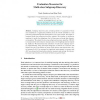Free Online Productivity Tools
i2Speak
i2Symbol
i2OCR
iTex2Img
iWeb2Print
iWeb2Shot
i2Type
iPdf2Split
iPdf2Merge
i2Bopomofo
i2Arabic
i2Style
i2Image
i2PDF
iLatex2Rtf
Sci2ools
PKDD
2009
Springer
2009
Springer
Evaluation Measures for Multi-class Subgroup Discovery
Subgroup discovery aims at finding subsets of a population whose class distribution is significantly different from the overall distribution. It has previously predominantly been investigated in a two-class context. This paper investigates multi-class subgroup discovery methods. We consider six evaluation measures for multi-class subgroups, four of them new, and study their theoretical properties. We extend the two-class subgroup discovery algorithm CN2-SD to incorporate the new evaluation measures and a new weighting scheme inspired by AdaBoost. We demonstrate the usefulness of multi-class subgroup discovery experimentally, using discovered subgroups as features for a decision tree learner. Not only is the number of leaves of the decision tree reduced with a factor between 8 and 16 on average, but significant improvements in accuracy and AUC are achieved with particular evaluation measures and settings. Similar performance improvements can be observed when using naive Bayes.
Data Mining | Multi-class Subgroup | Multi-class Subgroup Discovery | PKDD 2009 | Subgroup Discovery |
| Added | 27 May 2010 |
| Updated | 27 May 2010 |
| Type | Conference |
| Year | 2009 |
| Where | PKDD |
| Authors | Tarek Abudawood, Peter Flach |
Comments (0)

